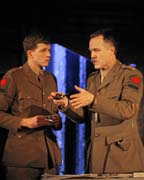
Paulanne Simmons
World War I Has a Message for the 21st Century
''Journey's End''
Directed by David Grindley
Belasco Theatre
111 West 44th St.
Opened Feb. 22, 2007
Tues. thru Sat. 8 p.m., matinees Wed. & Sat. 2 p.m., Sun. 3 p.m.
$36.25-$96.25 (212) 239-6200 or www.telecharge.com
Reviewed by Paulanne Simmons March 1, 2007
War is hell. Everyone says it. Everyone knows it. Yet most books, films and plays manage in some subtle way to romanticize war so that it doesn't seem so hellish after all. Not so with R.C. Sherriff's 1928 play ''Journey's End.''
Sherriff claimed his work was inspired by the men who had served with him in the 9th East Surrey Regiment on the Western Front during World War I. He insisted it was not an anti-war play. London audiences who saw ''Journey's End'' first at the Apollo Theatre and a few weeks later at the Savoy Theatre, thought differently, and so it will be with this latest production, which comes to New York City from London, just when we need it most.
 |
| Scene in ''Journey's End ''. Photo by Paul Kolnik |
''Journey's End'' takes place on March 20, 1918, the eve of Field Marshal Ludendorff's Spring Offensive. All of the action takes place in a dark, candlelit dugout, where men wearing greatcoats, with gasmasks hanging down on their chests plan the attack while they try to keep the pieces of their lives together. (Jonathan Fensom is the set, as well as the costume designer.)
The men's dreary existence and down-to-earth conversation centers mostly on what they are going to eat and who is going to take over the next watch. But it is clear from the first few minutes of ''Journey's End'' that one or two of these stalwart, frightened, naïve and cynical soldiers is not going to make it to the end. The only question is who.
It could be the regiment hero, Captain Stanhope (the powerful Hugh Dancy), who has been on the field the longest and only manages to survive by anesthetizing himself with alcohol. So tightly wound up that his speech seems to be forced from him, Stanhope may be doomed whatever the outcome of his war experience.
Or it might be the staid and kindly Lieutenant Osborne (Boyd Gaines), the only man Stanhope can confide in; or the overweight and jocular 2nd Lieutenant Trotter (John Ahlin).
Second Lieutenant Raleigh (the lyrical Stark Sands), who joins the regiment in order to be with Stanhope, his childhood hero, and doesn't seem to have much of an idea what he has let himself in for, is also a likely candidate. Raleigh is both Stanhope's foil and one of the best, if unwitting, arguments against war ever put on stage.
David Grindley directs with the same unrelenting decisiveness as death on its march. He builds the pace slowly and mercilessly, until when the curtain falls, the play is so powerful it's possible to forget that this is a theater and those are only actors onstage.
Every detail in ''Journey's End'' works. Even the relatively minor characters like the punctilious cook, Private Mason (Jefferson Mays) are superb. Grindley understands the eloquence of both silence and the imagination. He lets the sounds of war substitute for the blood and guts a lesser director might think obligatory.
''Journey's End'' is brought to New York by the same people behind ''History Boys.'' When it was staged in London it was supposed to have an 8-week run in the West End in honor of the 75th anniversary of its first production, but instead it ran for two years and had two national tours.
Considering its timely message and terrific staging, it
may have a similar success in New York City. Better get your tickets now.
| lobby | search
| home | cue-to-cue |
discounts | welcome | film
| dance | reviews |
| museums | NYTW
mail | recordings | coupons |
publications | classified |
